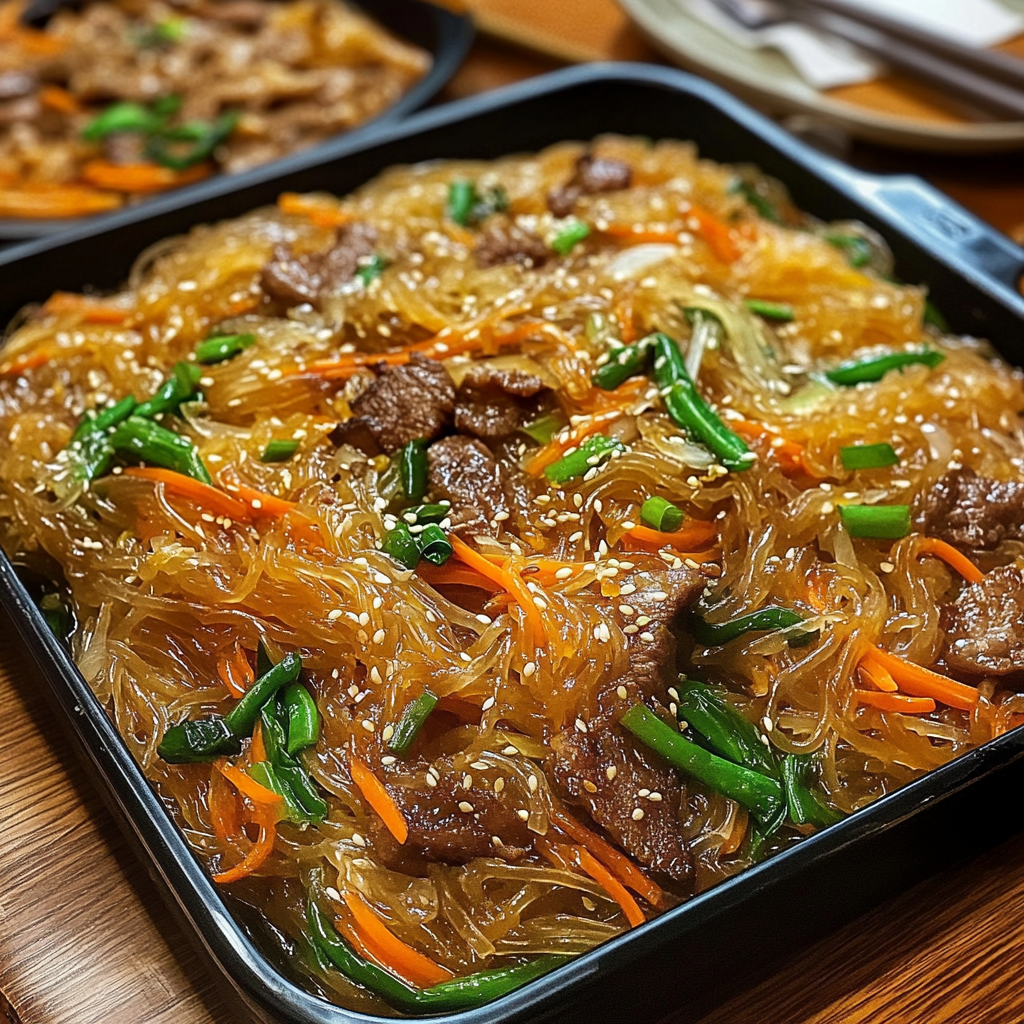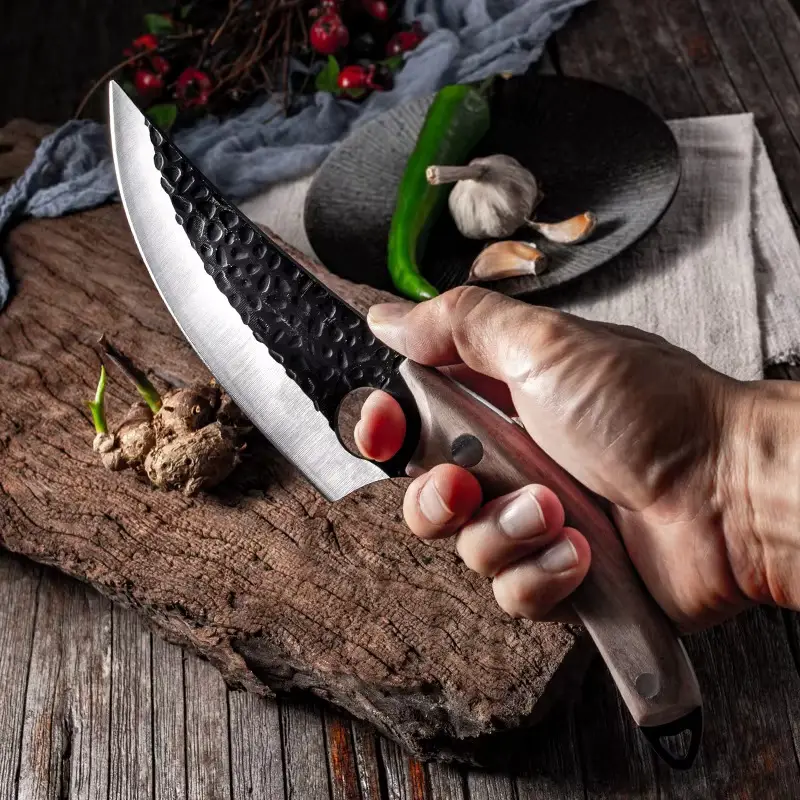Japchae (잡채) is a beloved Korean stir-fried noodle dish made with sweet potato starch noodles, colorful vegetables, and a deliciously savory-sweet sauce. This classic Korean dish is often served during celebrations, holidays, and special gatherings because of its beautiful presentation and irresistible taste. The dish’s name, “Japchae,” translates to “mixed vegetables,” highlighting its origins as a vegetable-based dish before glass noodles (dangmyeon) became a key ingredient.
Originally created in the 17th century for a royal banquet, Japchae has since evolved into a staple of Korean cuisine, enjoyed both as a main dish and a side dish (banchan). The chewy texture of the noodles, combined with the umami-rich sauce and fresh vegetables, creates a balanced and satisfying dish that’s both healthy and flavorful.
Whether you’re preparing Japchae for a festive occasion or simply craving an authentic Korean meal, this recipe will guide you through each step to achieve the perfect homemade Japchae with traditional flavors.
Why You’ll Love This Recipe
- Authentic Korean Flavor – This recipe follows traditional cooking methods and ingredients, ensuring an authentic taste just like what you’d find in Korea.
- Perfectly Balanced Taste – The harmony of sweet, savory, and umami flavors makes Japchae an irresistible dish.
- Healthy and Nutritious – Packed with fresh vegetables and lean protein options, Japchae is a wholesome meal.
- Versatile and Customizable – You can adjust the ingredients to suit your dietary preferences or available ingredients.
- Great for Any Occasion – Whether it’s a casual meal, a potluck, or a festive gathering, Japchae is always a crowd-pleaser.
Preparation Time and Servings
- Prep Time: 25 minutes
- Cook Time: 15 minutes
- Total Time: 40 minutes
- Yield: 4 servings
- Serving Size: 1 plate
Nutritional Information (per serving)
- Calories: 320
- Carbohydrates: 52g
- Protein: 8g
- Fat: 8g
- Fiber: 4g
- Sugar: 7g
Ingredients
For the noodles:
- 200g (7 oz) sweet potato starch noodles (dangmyeon)
- 1 teaspoon sesame oil (for tossing the noodles)
For the sauce:
- 3 tablespoons soy sauce
- 1 tablespoon sesame oil
- 1 tablespoon sugar (or honey for a natural alternative)
- 1 teaspoon rice vinegar (optional, for added depth)
- 1 teaspoon minced garlic
- 1/2 teaspoon black pepper
For the vegetables and protein:
- 1 medium carrot, julienned
- 1 red bell pepper, thinly sliced
- 1 small onion, thinly sliced
- 1 cup spinach, blanched and squeezed dry
- 5-6 shiitake mushrooms, sliced
- 1/2 cup wood ear mushrooms (optional)
- 2 green onions, chopped
- 1/2 cup cooked beef, chicken, or tofu (optional, for added protein)
- 1 tablespoon vegetable oil (for stir-frying)
For garnish:
- 1 teaspoon toasted sesame seeds
- 1 egg yolk, cooked and julienned (optional)
Step-by-Step Instructions
Step 1: Prepare the Sweet Potato Noodles
- Bring a large pot of water to a boil and add the sweet potato starch noodles.
- Cook according to the package instructions, usually about 6–8 minutes, until the noodles are soft and chewy.
- Drain the noodles and rinse them under cold running water to stop the cooking process.
- Toss the noodles with 1 teaspoon of sesame oil to prevent them from sticking together and set them aside.
Step 2: Prepare the Vegetables and Protein
- Blanch the spinach in boiling water for about 30 seconds, then drain and squeeze out excess water. Set aside.
- Heat 1 tablespoon of vegetable oil in a large pan over medium-high heat.
- Add the onions and sauté for 1–2 minutes until slightly softened.
- Add the carrots, bell peppers, and mushrooms, stirring frequently until the vegetables are tender but still vibrant.
- If using cooked beef, chicken, or tofu, add it at this stage and stir-fry for another 1–2 minutes.
Step 3: Make the Sauce
- In a small bowl, whisk together soy sauce, sesame oil, sugar, minced garlic, black pepper, and rice vinegar (if using).
- Taste the sauce and adjust seasoning as needed.
Step 4: Combine Everything
- Add the cooked noodles to the pan with the vegetables and protein.
- Pour the sauce over the noodles and toss everything together until evenly coated.
- Add the blanched spinach and chopped green onions, mixing gently to incorporate.
Step 5: Garnish and Serve
- Transfer the Japchae to a serving platter.
- Sprinkle toasted sesame seeds over the top.
- If desired, garnish with thinly sliced cooked egg yolk for a traditional presentation.
- Serve warm or at room temperature. Enjoy!
Ingredient Background
Sweet potato starch noodles, also known as dangmyeon (당면), are naturally gluten-free and have a unique chewy texture. These noodles absorb flavors well, making them perfect for stir-fried dishes like Japchae.
Soy sauce adds umami depth, while sesame oil gives the dish a nutty aroma. The combination of fresh vegetables ensures a vibrant color palette and a variety of textures. Protein options like beef, chicken, or tofu make Japchae a satisfying and balanced dish.
Technique Tips
- To prevent the noodles from becoming mushy, rinse them under cold water immediately after cooking.
- Stir-fry each vegetable separately for the best texture and color retention.
- Use high heat for a quick stir-fry to keep the vegetables crisp.
- If the noodles seem dry after mixing, add a splash of sesame oil or soy sauce.
Alternative Presentation Ideas
- Serve Japchae in a lettuce wrap for a fun, bite-sized appetizer.
- Garnish with julienned chili peppers for a spicy kick.
- Top with shredded seaweed (gim) for added umami flavor.
Additional Tips for Success
- Prepare all ingredients in advance to make the cooking process smoother.
- Adjust sweetness by adding more or less sugar depending on your preference.
- For an extra umami boost, add a splash of mushroom or anchovy broth.
Recipe Variations
- Spicy Japchae: Add gochugaru (Korean chili flakes) or a dash of gochujang for a spicy twist.
- Vegan Japchae: Omit meat and use extra mushrooms or tofu.
- Seafood Japchae: Add shrimp or squid for a seafood version.
Freezing and Storage
- Store leftover Japchae in an airtight container in the refrigerator for up to 3 days.
- Reheat in a pan with a splash of water or sesame oil to revive the texture.
- Japchae is not ideal for freezing, as the noodles can become too soft when thawed.
Healthier Twist Ideas
- Reduce oil for a lighter version.
- Use coconut aminos instead of soy sauce for a lower-sodium option.
- Add more leafy greens for extra nutrients.
Serving Suggestions for Events
- Korean BBQ Night: Serve Japchae as a flavorful side dish.
- Holiday Celebrations: A colorful addition to any festive meal.
- Lunchbox Meal: Pack Japchae in a bento box for a nutritious lunch.
Special Equipment
- Large pot (for boiling noodles)
- Strainer (for rinsing noodles)
- Large frying pan or wok (for stir-frying)
Frequently Asked Questions
1. Can I make Japchae ahead of time?
Yes! Japchae tastes great at room temperature, making it perfect for meal prep or gatherings.
2. Can I use other noodles instead of sweet potato noodles?
For authenticity, stick with sweet potato starch noodles, but rice noodles can be used as a substitute.
3. Is Japchae served hot or cold?
Japchae is typically served warm or at room temperature.
4. Can I use pre-cut vegetables?
Yes, but freshly sliced vegetables will have better texture and flavor.
5. Can I make Japchae without soy sauce?
You can use tamari or coconut aminos as a soy sauce substitute.



